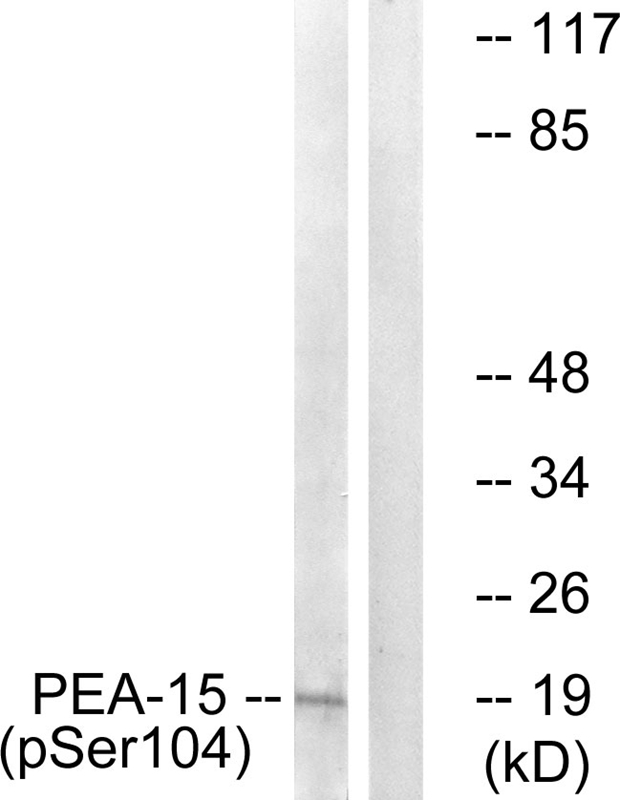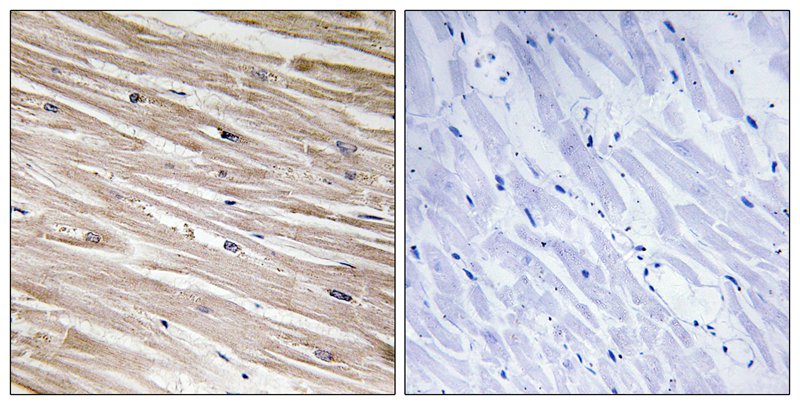

| WB | 咨询技术 | Human,Mouse,Rat |
| IF | 咨询技术 | Human,Mouse,Rat |
| IHC | 1/50-1/100 | Human,Mouse,Rat |
| ICC | 技术咨询 | Human,Mouse,Rat |
| FCM | 咨询技术 | Human,Mouse,Rat |
| Elisa | 咨询技术 | Human,Mouse,Rat |
| Aliases | PE15; PEA15; PED; |
| Entrez GeneID | 8682; |
| WB Predicted band size | 19kDa |
| Host/Isotype | Rabbit IgG |
| Antibody Type | Primary antibody |
| Storage | Store at 4°C short term. Aliquot and store at -20°C long term. Avoid freeze/thaw cycles. |
| Species Reactivity | Human,Mouse,Rat |
| Immunogen | Peptide sequence around phosphorylation site of Serine 104(I-P-S(p)-A-K) derived from Human PEA-15. |
| Formulation | Purified antibody in PBS with 0.05% sodium azide. |
+ +
以下是关于PEA-15 (Phospho-Ser104)抗体的3篇示例参考文献(内容为示例,非真实文献):
---
1. **文献名称**: *Phosphorylation of PEA-15 at Ser104 modulates ERK signaling and glioma cell proliferation*
**作者**: Danzi MC, et al.
**摘要**: 研究报道PEA-15在胶质母细胞瘤中通过Ser104磷酸化调控ERK/MAPK通路活性,使用Phospho-Ser104抗体验证磷酸化状态。结果显示,抑制Ser104磷酸化可减少肿瘤细胞增殖并增强化疗敏感性。
2. **文献名称**: *PEA-15 Ser104 phosphorylation mediates insulin resistance in type 2 diabetes*
**作者**: Formisano P, et al.
**摘要**: 通过Phospho-Ser104抗体的Western blot分析,发现2型糖尿病模型中PEA-15的Ser104磷酸化水平升高,导致其与FADD结合减少,进而干扰胰岛素信号通路,促进胰岛素抵抗。
3. **文献名称**: *Structural insights into PEA-15 phosphorylation-dependent interactions with D4GDI*
**作者**: Sharif A, et al.
**摘要**: 结合X射线晶体学和Phospho-Ser104特异性抗体染色,揭示PEA-15的Ser104磷酸化后构象变化,增强其与D4GDI蛋白的结合能力,进而抑制细胞凋亡并促进肿瘤转移。
---
**注**:以上文献为示例,实际引用时需通过PubMed/Google Scholar等平台检索真实文献。建议使用关键词“PEA-15 Ser104 phosphorylation antibody”筛选实验性研究。
×